Reptiles of all shapes and sizes have become popular pets over the last few years, but reptiles in the wild can be pretty terrifying. Komodo dragons and crocodiles are some of the largest and most fierce reptiles in the animal kingdom, but how do these animals differ, and what characteristics do they share?
Komodo dragons and crocodiles are similar in that they are reptiles that lay eggs, eat meat, and manage well in water. But crocodiles are far larger in size and weight and have a much more lethal bite. Both animals are dangerous to humans, but crocodiles are more robust and powerful.
When comparing a Komodo Dragon vs Crocodile, we need to look at each individually to better understand how they survive.
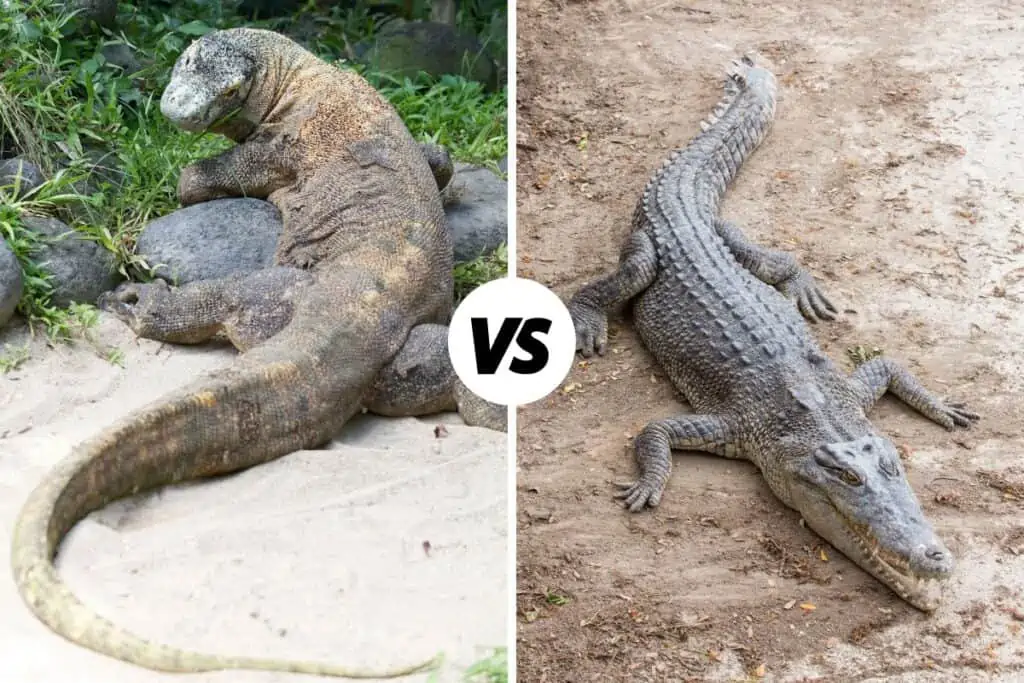
Komodo Dragon vs Crocodile
Because both crocodiles and Komodo dragons are reptiles, it doesn’t mean they are all that similar.
They do share some similarities, but they function quite differently. Let’s take an in-depth look.
The Komodo Dragon
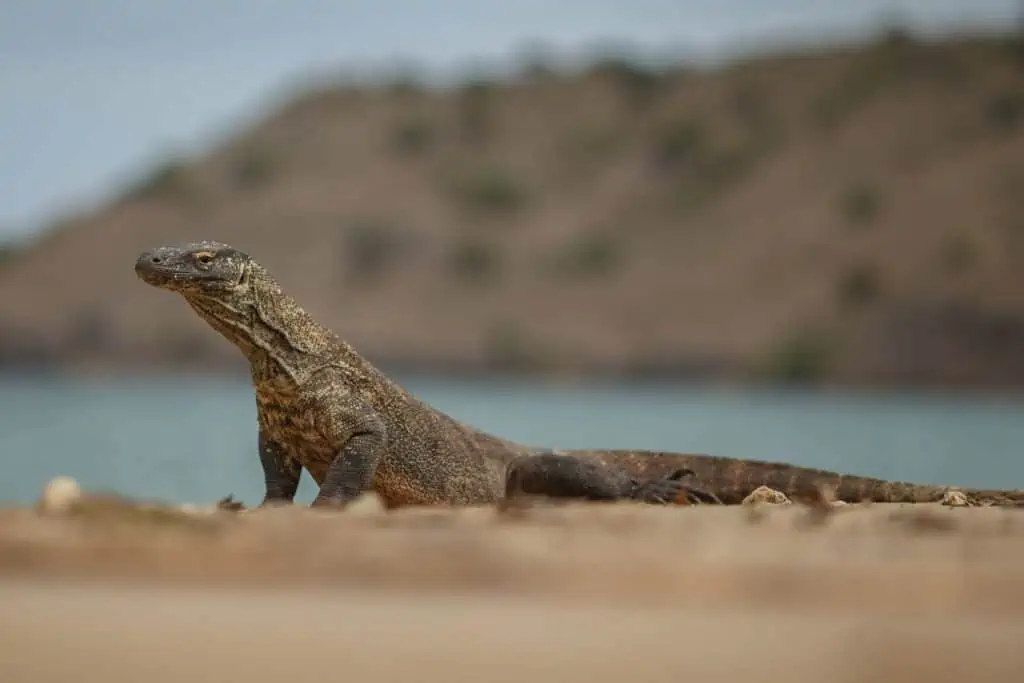
Belonging to the monitor lizard family, Komodo dragons are reptiles inhabiting the Indonesian islands. This includes the islands of Komodo, where their name stems, and Rinca, Flores, and Gili Motang.
These massive lizards were first reported by scientists in 1910, and they are respected as one of the most feared lizards in the world – not just for their sheer size but their scary appearance too.
The largest of the lizard specials, Komodo dragons can grow up to 10 ft in length and weigh upwards of 150 pounds. Some males tip the scales at over 200 lb.
The largest Komodo dragon on record was verified at 10.3 ft in length and over 366 lb in weight.
They have a small head and a tail that is as long as their body. This tail is thick and muscular and can be so powerful as to take down other animals with a single swipe.
Primarily this is used to scare away anything that threatens it, but it can do severe damage if it hits you. It’s also useful when they swim – Komodo dragons have been known to swim up to 300 meters in one go.
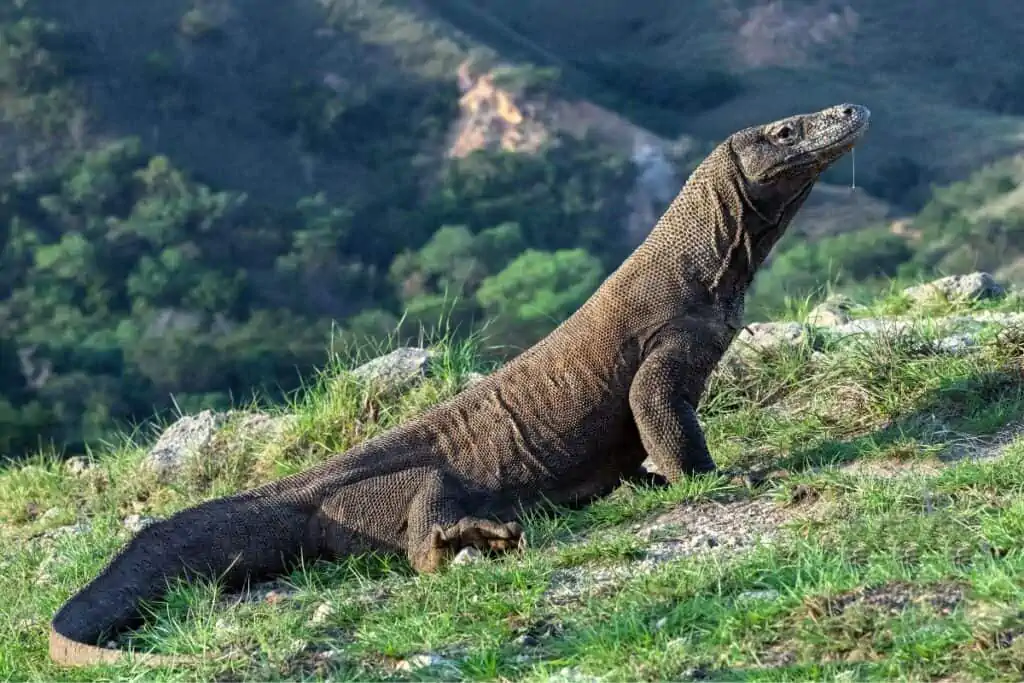
The tell-tale reptilian flicking tongue of the Komodo dragon is long, deeply forked, and yellow. It pokes out from behind around sixty serrated teeth that can be as long as an inch each.
If they fall out, these teeth also replace themselves, so the Komodo dragon has a constant supply of terrifying teeth to fight, hunt, and shred meat with.
And meat is definitely on the menu – Komodo dragons are carnivores, as their name suggests. They will consume meat they can get their hands on, including large deer, slow birds, and even humans.
They are also believed to be cannibalistic in that the larger Komodo dragons will eat smaller ones without hesitation. They will consume their entire body weight in meat in one meal, too.
They aren’t overly picky about their meat and have a fantastic smell that will pick up on rotting meat from up to 2.5 miles away.
It was once believed that loads of bacteria in their mouths made their saliva venomous, but modern research shows us that Komodo dragons secrete venom proteins similarly to snakes.
They have venom that prevents blood clotting and lowers blood pressure, which causes massive bleeding once they have bitten their prey.
But unlike snakes, Komodo Dragons have powerful legs that can run as fast as 13 mph (21 kph).
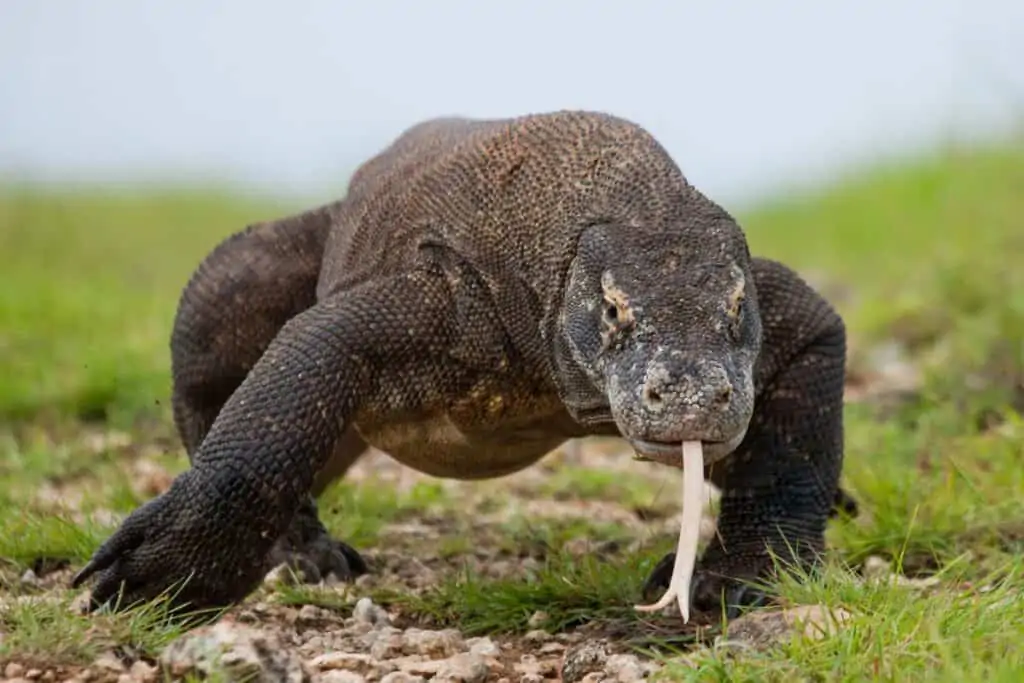
It’s important to know that Komodo dragons are also an endangered species classified as vulnerable. As they only have a small area of natural habitat, they aren’t overly high in numbers. And with humans poaching animals and destroying their natural habitat, their numbers have dwindled.
Komodo dragons can live for up to thirty years. They mate and lay eggs once a year, with males fighting for the right to mate with fertile females. She will then lay around thirty eggs in the ground, which only hatch after eight months.
But what happens if there aren’t any females to mate with?
Komodo dragons have male and female chromosomes and can reproduce asexually via parthenogenesis. Sadly, this process only results in male offspring, making it more challenging to continue to breed.
The Crocodile
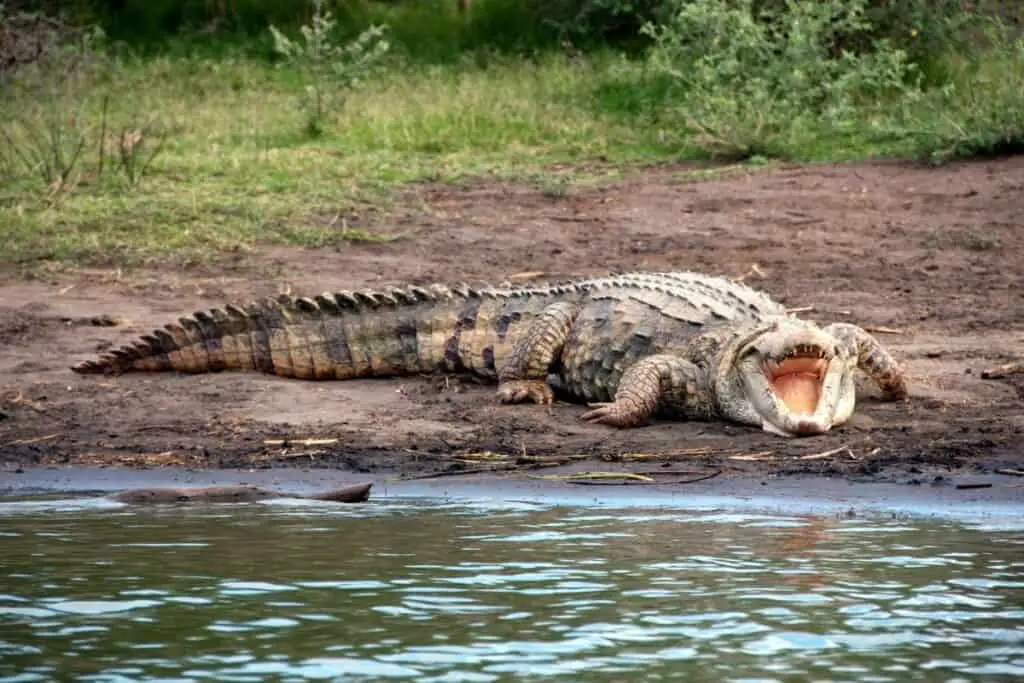
Another giant reptile, the crocodile, shares some similarities with Komodo dragons. But whereas Komodo dragons belong to a tiny region, you can find crocodiles across the world in Africa, Asia, Australia, and the Americas, with thirteen species total.
These species vary from about 5.6 feet to over 23 feet and can weigh as much as 2,000 lbs.
The most noticeable thing about a crocodile is how ancient it looks, with many saying they resemble dinosaurs and dragons the most. This is due to their plated, knobbly, and scaly skin.
They have long, powerful tails that help them to swim and massive mouths filled with terrifying teeth. Their eyes sit at the top of their heads, where they can quickly peak above the water to observe the world around them.
Crocodiles spend most of their time in the water, tucking their feet against their bodies to provide a torpedo-like shape that helps them move through the water at incredible speeds of up to 20 mph (32 kph).
They also have webbed feet to aid in this and to help them make faster turns.
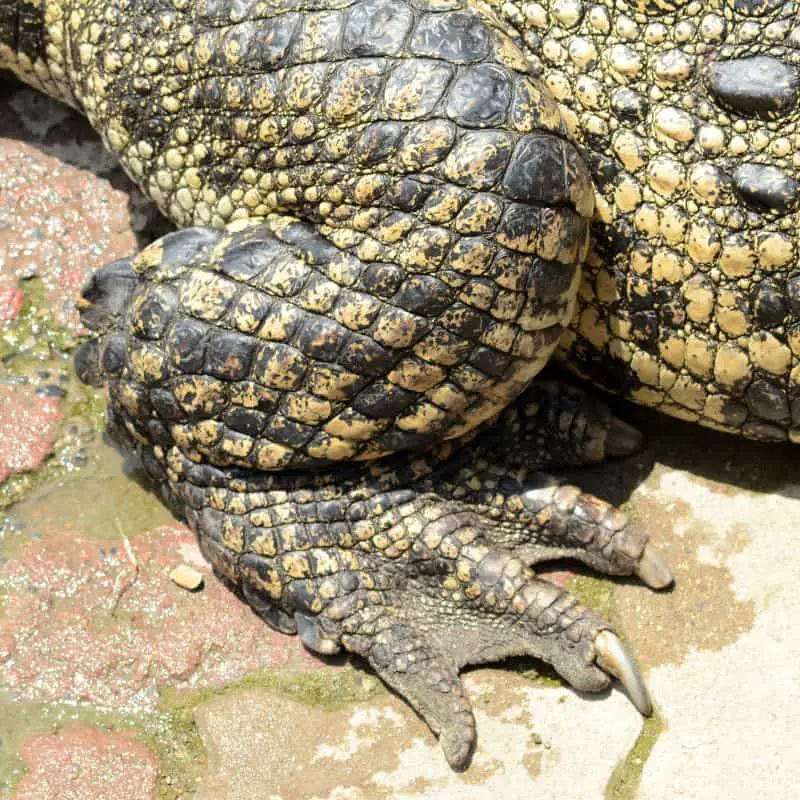
They spend some time on land, where they can run at about 14 mph (22 kph), but only for short distances. They prefer being in the water, where they often lie in wait for unsuspecting prey.
They can also hold their breath for more than an hour and can often be seen blissfully drifting along with only their eyes visible.
As carnivores, crocodiles have adapted into some of the most advanced predators in the world. They are incredibly strong, with jaws that produce forces up to 5,000 psi – this is by far the strongest measured bite in the animal kingdom.
By contrast, the muscles that open their jaws are fragile, so keeping their jaws shut is an easy task – keeping a crocodile’s jaw from shutting is near impossible, however.
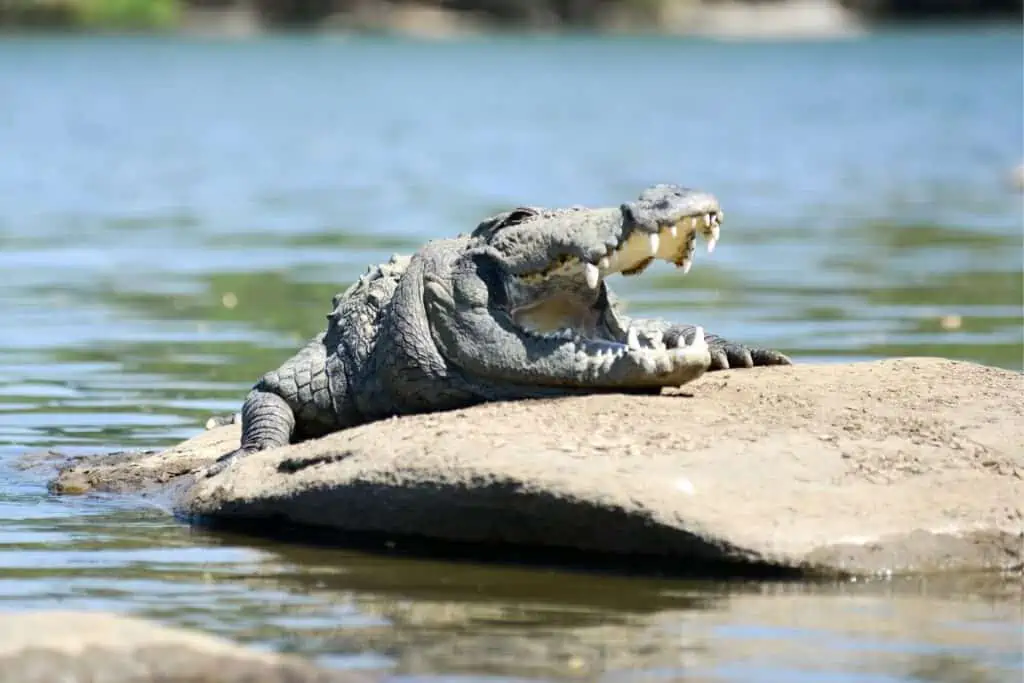
When hunting, they rely on brute strength and will grab their prey in their powerful jaws and drag them underwater to drown them. Unable to chew or tear up their food, crocodiles swallow their food whole.
They also ingest small stones or rocks to help grind up the food in their stomachs. And while they can eat a staggering amount of meat, they can also manage for weeks at a time without food if they need to.
With all those jagged teeth in their mouth doing so much biting, it stands to reason they will likely lose teeth often.
They generally have somewhere between 60 and 110 individual teeth, and should any of these break; they are generally quickly replaced – crocodiles can replace each of their teeth up to fifty times throughout their lives.
Like other reptiles, crocodiles are cold-blooded, and their temperature does not regulate automatically. To keep cool, they open their mouths to release heat. And when they are cold, they can be found baking in the sun. While they are sleeping, they can also sleep with one eye open.
When it comes to laying eggs, females lay around a dozen eggs at a time, sometimes as many as 60 – these take between 55 and 100 days to hatch. An interesting fact about crocodiles is that the egg’s temperature determines the sex of each baby crocodile during the first half of its incubation.
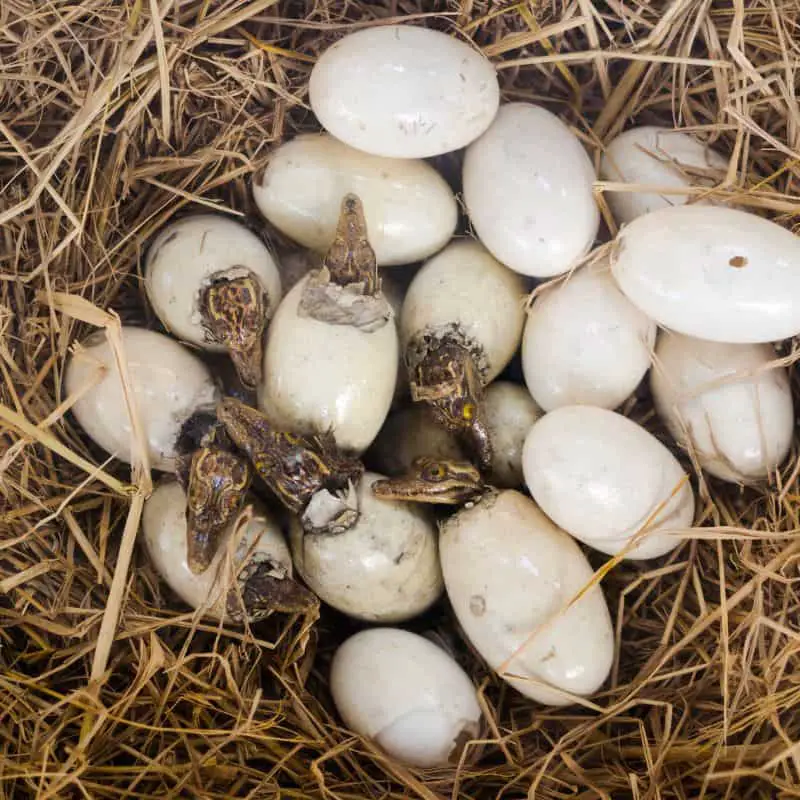
Not all baby crocs survive once they’ve hatched, with larger crocs sometimes eating the smaller crocodiles.
These large predators are known to live very long, with some species passing 75 years old. Crocodiles only mature to reproduce between four and 15 years old; some of the oldest known crocodiles have lived for over a century.
Similarities Between Komodo Dragons and Crocodiles
Let’s discuss some of the similarities between Komodo dragons and crocodiles first:
1. Classification
Both Komodo dragons and crocodiles belong to the Chordata phylum and are reptiles.
Though each belongs to a different order, they are similarly cold-blooded and reptilian.
2. Diet
Carnivorous predators, Komodo dragons and crocodiles, eat mainly meat. Their hunting style is similar, with both reptiles using ambush techniques to hunt and kill their prey.
And similarly, both species have been known to eat their own kind. Both also have many teeth that can fall out and be replaced.
3. Reproduction
Komodo dragons and crocodiles both reproduce by laying eggs that hatch their babies.
Differences Between Komodo Dragons and Crocodiles
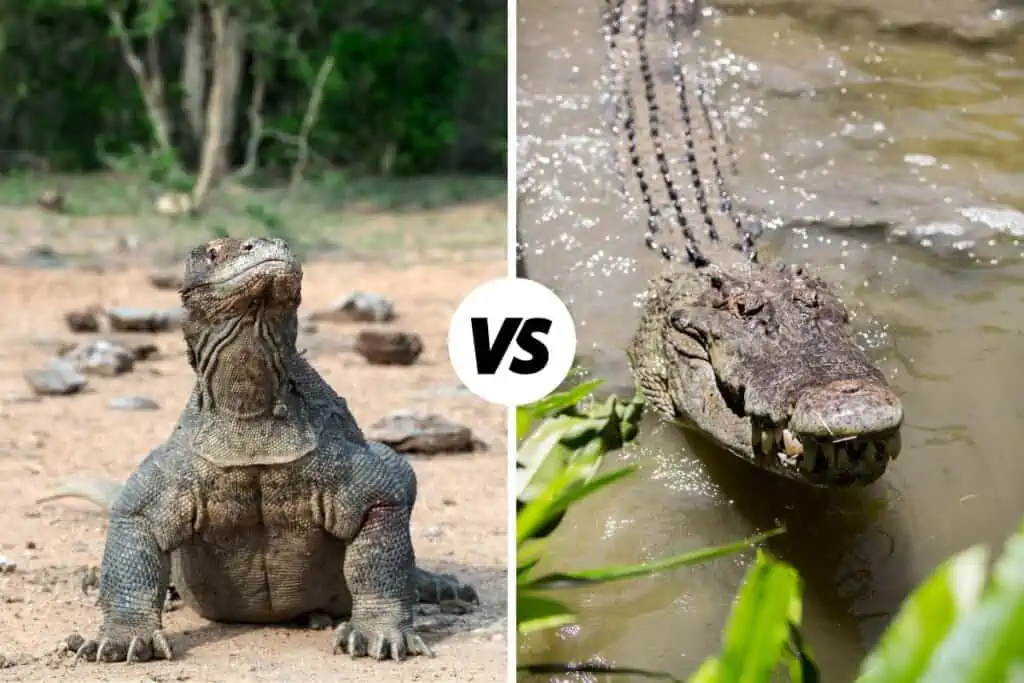
There are a lot more aspects that make these animals different than alike.
Here are some of the key differences:
1. Size and strength
While Komodo dragons are by no means small, they are not nearly as large as some of the bigger crocodile species.
The largest crocodiles are significantly more powerful and have a much stronger bite.
And whereas Komodo dragons have venomous proteins to make hunting easier, crocs rely on brute strength alone.
2. Tongue
Komodo dragons have a characteristic snake-like tongue that flickers to taste the air around them.
Crocodiles don’t have a tongue like this at all.
3. Habitat
While both animals can swim, crocodiles spend much of their time in the water. They are considered amphibious, whereas Komodo dragons are not as water-bound.
Komodo dragons are also only found in certain places in the world, and crocodiles occur across a broader geographic spectrum – there are many different species of crocodile, too.
4. Numbers
Following the above, Komodo dragons are considered a vulnerable species, whereas crocodile numbers are a bit higher.
However, several croc species have been listed as critically endangered due to poaching and habitat loss due to deforestation.
Komodo Dragon vs Crocodile: Are They Dangerous To Humans?
When considering which of these animals is more dangerous to humans, the answer is quite simple, both.
Tangling with either of these will not have a happy ending. Considering both are carnivores, neither would back down from a potential meal. Both of these predators can catch you over short distances, too – and if they happen to catch you unawares in an ambush, you aren’t likely to survive.
Komodo dragons have additional offensive capabilities that include venom and claws that hold prey in place, so if they catch a human, chances aren’t good that they can escape.
And should a crocodile grab onto you and drag you into the water, its ‘death roll‘ will prove fatal long before they manage to gulp you down.
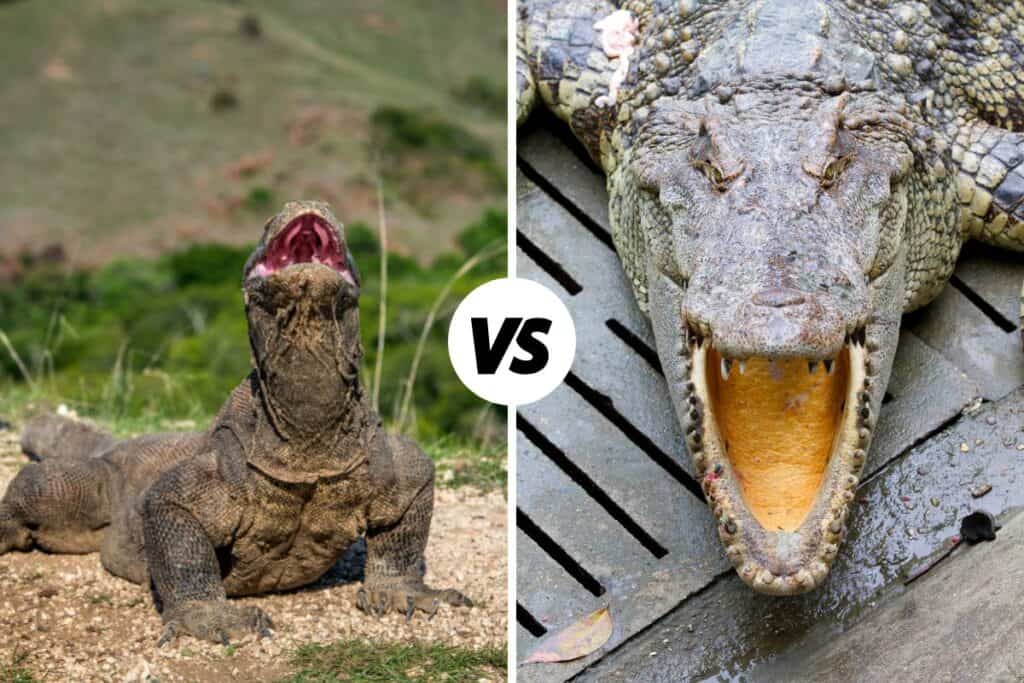
Komodo Dragon vs Crocodile: Which One Would Win In A Fight?
In the unlikely event that these two apex predators meet, a fight between a Komodo dragon and a crocodile will likely come down to sheer size and strength.
Crocodiles have the upper hand, with a much larger body and a massive bite force that will quickly dominate the Komodo dragon.
The only upper hand a Komodo dragon may have is if it is larger in size than the crocodile in question. They may be venomous, but their bite may not be powerful enough to break the crocodile’s armor-like skin and cause any damage – but this depends on the size.
For the most part, crocodiles are the stronger animal, but as these animals don’t share the same habitat, an altercation is something we should never see happen.
Final Thoughts On The Differences Between Komodo Dragons And Crocodiles
Crocodiles and Komodo dragons are similar in that they are both cold-blooded reptiles that lay eggs and eat meat, but their similarities also end there.
Crocodiles are much larger, more powerful, live longer than Komodo dragons, and are found in more places across the globe.
Both are incredibly dangerous to humans, so you should not approach these animals.
Komodo Dragons and several Crocodile species are endangered species, and we need to do what we can to protect them before they disappear for good.
